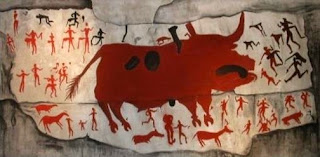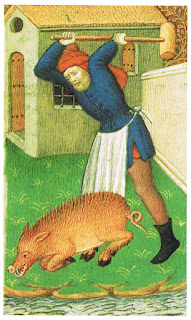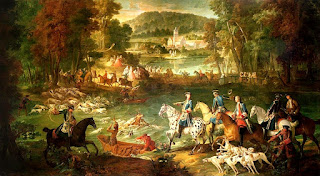"The fear of you and the dread of you shall be
upon every beast of the earth and upon every bird of the heavens, upon
everything that creeps on the ground and all the fish of the sea. Into
your hand they are delivered. Every moving thing that lives shall be
food for you. And as I gave you the green plants, I give you everything."
Genesis 9:2-3
Sunday, December 26, 2021
Christmas, Nature, and the Art of Slaughter
There is no doubt that
Christmas is a time when we become aware of the precariousness of nature
as the sun's light fades, leaves fall off the trees and the weather
gets colder. The sun seems to stop moving (solstice) for three days, and
then as if by magic starts moving again in the other direction and
seems to be reborn. This phenomenon was noticed thousands of years
before Christian celebrations of the birth of Jesus. At some point,
elements of Saturnalia, Midwinter, Yule and other pagan traditions
became merged into the general Christmas traditions that are observed
today. It is a festival that celebrates life in all its forms. Christmas
cards glorify nature in their depictions of many types of snowy
woodland scenes and animals: robins, reindeer, donkeys, sheep, oxen
(bullocks), doves, etc. In every culture today there are still elements
of nature-worship: in the maintenance of old traditions like
the goddess
Pachamama
(revered by the indigenous peoples of the Ande) or various forms of neo-paganism that hark back to pre-Christian times.
Çatalhöyük Wall Paintings, Çatalhöyük, Bull hunting scene. Copies of painting on plaster. 6 th millennium BC.
Modern secular paganism
places "great emphasis on the divinity of nature" while the animistic
aspects of Pagan theology asserts "that all things have a soul - not
just humans or organic life - so this bond is held with mountains and
rivers as well as trees and wild animals." For example:"Secular
Paganism is a set of principles shared by diverse groups around the
world. It is a natural outgrowth of many peoples’ personal ethics and
beliefs about life. It is not a religion but rather an ethical view
based on the belief that nature is sacred and must be respected and
treasured. Secular Pagans believe that we are a part of nature, not her
master."
Illustration of medieval pig stunning, from The Medieval Cookbook
However, our relationship with nature is contradictory and we
treat the different parts of nature in very different ways. This can be
seen in the way we treat some animals as pets, others as a danger, and
most as a source of food that is produced on a massive industrial scale
with slaughterhouses, factories, and many forms of processing. This is
reflected in art down through the ages, some of which glorifies hunting
and killing animals, and some which tries to show the terror animals are
put through before coming to a grisly end. In her book Why We Love Dogs, Eat Pigs, and Wear Cows: An Introduction to Carnism,
Melanie Joy tries to make sense of this and theorizes a distinction
between carnivores and carnists: "Carnivores require meat in their diet
for survival, but carnists choose to eat meat based on their beliefs." Thus:
Psychic numbing describes the way we withdraw from overwhelming issues
like the contradiction between our love of animals and the way we treat
them. It can be the way we deal with many big problems such as "impending doom, chaos, and ultimately mankind's extinction."
The Butcher and his Servant (1568), drawn and engraved by Jost Amman
We withdraw because we know that dealing with one serious issue
tends to open up many other interlinked issues, while, at the same
time getting progressively bigger as well as stretching backwards and
forwards in time.
Claudia von Werlhof grasps these widening problems and deals with them
head on. She believes that the essential problem is rooted in an
ideology which has as its basis a hatred for life itself. She blames the
centuries-old socio-political systems of
patriarchy
and capitalism that are "characterized by exploitation, extraction and
appropriation." She notes:
"The sinister motive of hating life needs to be hidden. The
unspeakable crimes that all patriarchies have committed against life
itself, against children, women, and all human beings, against the
Earth, animals, and plants must not be revealed. The hatred of life is
the reason and the rational justification for the violence against it; a
violence that intends to prevent any rebellion or uprising of those not
believing in the system it protects; a system that many would see as a
grave assault on their dignity if they only recognized it."
Furthermore she makes a distinction between killing and death:
"It
has been repeatedly suggested that the patriarchal system is a system
of death. That is not entirely correct. The patriarchal system is a
system of killing, that is of artificial death: ecocide, matricide,
homicide in general and finally “omnicide,” the killing of everything.
[...] We are up against a totalitarian system that does not care for its
subjects, that cannot (or no longer) be stopped, and that is constantly
becoming faster and more efficient in its attempt to end life on this
planet – while turning even this very process into a tool for further
accumulation of profit and power."
Man's best friend, animals' worst enemy
Over
the centuries the system of killing has become more and more
sophisticated. In art, depictions of hunting show changes from trapping
to chasing with dogs to shooting with guns. In many paintings dogs are
the 'collaborationists' who turn on their fellow animals for the benefit
of their masters.
A 14th-century depiction of boar hunting with hounds from Tacuina sanitatis (XIV century)
Jean-Baptiste Oudry, Hunting At The Saint-jean Pond In The Forest Of Compiegne, Before 1734
In one extraordinary set of paintings by the artist
Paulus Potter (1625–1654),
Punishment of a Hunter, we see different forms of entrapment and
killing depicted around two central paintings, one of which shows the
hunter going on trial before a court of animals, while the other shows
some animals dancing for joy as the 'treacherous' dogs are hung and the
dead hunter is roasted in a roaring fire.
Punishment of a Hunter, painting with 14 frames by Paulus Potter, 1 of which is by Cornelis van Poelenburgh (ca.1650)
Frans Snyders (1579-1657) (studio of) - The Fowl Market
Changing
attitudes towards hunting and selling of animal carcasses has been
growing in recent decades and can be seen similarly in the artistic
depiction of such practices as Maxwell Williams notes: "Upset
students at Cambridge University successfully petitioned to have a
painting depicting a butcher removed from their dining hall. The
painting, The Fowl Market by the studio of early-17th-century
Dutch painter Frans Snyders, loomed large above those in the dining room
at Hughes Hall, a postgraduate school within Cambridge. The painting
depicts the butcher at his labors, surrounded by a veritable mountain of
dead animals. Nearby, a living dog appears to be barking."
Hunting the seas
Negative attitudes towards hunting on land also extend to
whale hunting and fishing as the seas are depleted of life and thus
potentially creating a catastrophic collapse of the marine ecological
cycle. Factory ships, fish farming and whaling have come in for much
criticism, while quotas for certain species of fish have been imposed by
governments due to overfishing. In the examples shown here we see
whale hunting being depicted as heroic as the hunters deal with huge
whales and fierce weather, then an ambivalent merchant, to a later
painting of a cruel, knife-wielding monger.
Robert Walter Weir Jr, Taking a Whale / Shooting a Whale with a Shoulder Gun (ca. 1855-1866)
Gyula Derkovits (1894-1934) - Fish seller (1930)
Slaughterhouse industry
The
greatest criticism in recent decades has been reserved for the
practices carried out in slaughterhouses using what were declared to be
'humane' ways of killing animals. Time and time again shocking,
secretly filmed footage has emerged of extreme cruelty towards sentient
beings uttering horrific shrieks as they are chased and battered to
death. In recent depictions shown here artists use Expressionist techniques
to try and depict the horror of the slaughterhouse bloodletting.
Lovis Corinth (1858–1925), Im Schlachthaus (1893)
Nicolai Fechin (1881–1955) - The Slaughterhouse (1919)
Sue
Coe (born 1951) is an English artist and illustrator who goes one step
further by using her works to benefit animal rights organizations as
well as illustrating books and essays to explore issues such as factory
farming and meat packing.
Sue Coe
- My mother and I watch a pig escape the slaughterhouse
The
struggle against all these different old and modern practices of
industrializing and converting our fellow beings into various types of
products seems to be finally taking hold of the popular imagination. In
a recent article
in the UK
Andrew Anthony wrote that:
"Meat consumption in this country has declined by 17% over the past decade. The Economist
magazine named 2019 “The Year of the Vegan”. And last year the World
Health Organization recommended a plant-based diet for a healthy life.
That endorsement, along with growing concerns about the impact of dairy
farming on the environment, combined with the lifestyle rethink enabled
by the lockdown, has significantly increased the number of people
turning their backs on animal products in the UK."
The Vegan Society commissioned research
that found that: "At least 542,000 people in Britain are now following a
vegan diet and never consume any animal products including meat, fish,
milk, cheese, eggs and honey. This is a whopping increase since the last
estimate of 150,000 ten years ago, making veganism one of Britain’s
fastest growing lifestyle movements." Furthermore, Jasmijn de Boo, CEO
of The Vegan Society commented
that "more people than ever before are acting upon the health and
environmental benefits of veganism, and finding out what really goes on
in the meat and dairy industries and deciding they do not want to
contribute to the pain and suffering of animals.” Maybe we are seeing
the seeds of a new enlightened attitude towards animals which will also
be reflected in a more positive art in the future.
Caoimhghin Ó Croidheáin is an Irish artist, lecturer and writer. His artwork
consists of paintings based on contemporary geopolitical themes as well
as Irish history and cityscapes of Dublin. His blog of critical writing
based on cinema, art and politics along with research on a database of
Realist and Social Realist art from around the world can be viewed
country by country here.
Subscribe to:
Post Comments (Atom)




























No comments:
Post a Comment